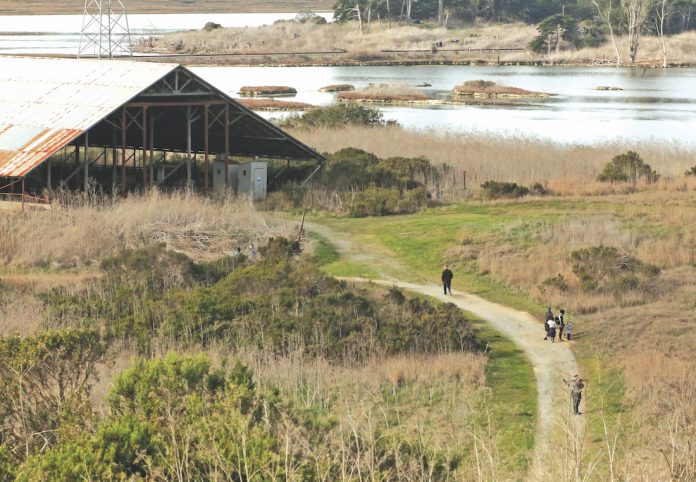By Erin Malsbury, Special to the Pajaronian
MOSS LANDING—The Ocean Protection Council (OPC) recently approved $1.3 million in funding for the final phase of the massive restoration project of the Elkhorn Slough wetlands, an effort that has been in the works since 2012.
Wetlands improve water quality, prevent soil erosion and provide important habitat for many species. Migrating birds stop to feed and rest in the space between land and sea, and many fish, birds and invertebrates use it as a nursery. But these ecosystems have become increasingly rare, says Monique Fountain, director of the Tidal Wetlands Project and lead on the slough’s restoration efforts.
“We’ve lost 90 percent of the wetlands in California and 50 percent in Elkhorn Slough,” Fountain said.
First, people drained and diked the area for duck hunting and cattle, Fountain says. Then, in 1947, a channel cut for the Moss Landing harbor flooded parts of the land with salt water.
“That really changed the hydrology,” said Dave Feliz, the national reserve manager.
Changes to the Salinas River also weakened the ecosystem. The river used to feed fresh water and sediment into the wetlands, but channels now direct it south of the slough.
“So, we have to create something that can exist without that,” Feliz said. “And also something that can exist with an ocean that we know is rising in elevation.”
To address the problems, more than 15 organizations and 60 scientists from different fields came together and created the three-part restoration project. The OPC funding enables the start of the final phase of the restoration, which will take place on the Elkhorn Slough National Estuarine Research Reserve, owned and managed by the California Department of Fish and Wildlife in partnership with NOAA and with support from the Elkhorn Slough Foundation.
WHAT IS BEING DONE
“When a wetland dries up or is drained, it compresses like a sponge,” Fountain said. “You end up with this marsh plain that’s too low to support healthy tidal marsh but too high to be a healthy mudflat.”
To resolve this problem, the team plans to raise the elevation of the wetlands. They will use soil from a nearby farm destroyed by saltwater intrusion.
“But we’re going one step further,” Fountain said. “We’re actually bringing that elevation up to the very top of the range that marsh can survive in.”
The group wants to give the wetlands the best chance at resiliency in the face of rising sea levels. Elevating the land and making sure a few key species are present provides a start. The marsh should then take care of the rest, says Fountain.
“When we talk about restoring, we’re not really restoring to any particular point in time,” Fountain said. “We’re really trying to bump it back into being self-sustaining.”
Figuring out how to rebuild the marsh proved difficult, but it’s another challenge entirely to actually carry out the job, Feliz says. With the new funding, the team and contractors with specialized equipment will get to work.
RESTORING STEWARDSHIP
A small portion of the $1.3 million will also support a different kind of restoration—one of land stewardship. Through the Amah Mutsun Land Trust, members of the Amah Mutsun Tribal Band will help build oyster reefs in the slough and create educational materials about their traditional relationship with the coast.
“The tribal band has done a lot of work to restore terrestrial landscapes, but their ancestors were coastal people as well,” said Sara French, the Amah Mutsun Land Trust’s interim executive director. “This project is a very small part of the $1.3 million that was awarded, but we hope this will be the start of much more significant engagement in Elkhorn Slough by the Amah Mutsun Tribal Band and the land trust.”
For other members of the public who want to get involved, Feliz says the reserve hopes to offer planting days in the fall.
“It’s important that we don’t just write off these coastal habitats,” he said. “There are things we can do about it. We don’t have to just sit by and watch it go away.”









